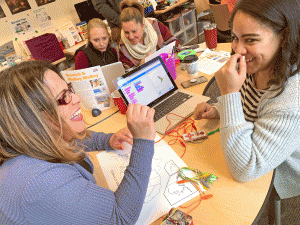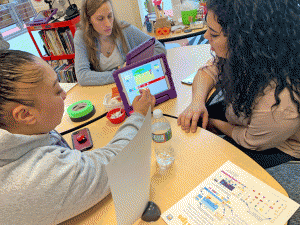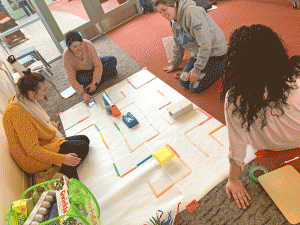
Lesley STEAM Learning Lab welcomed the entire faculty and administration from the Renaissance Community School in New Bedford, Mass, for a full day interactive workshop. Based on the school’s desire to integrate standards-based making into the curriculum, Lesley STEAM developed a series of projects to engage the staff in collaborative problem solving and inquiry-based learning.
The day kicked off with a partner making activity geared towards students, with an embedded reflection on what it means to be a successful collaborator. The challenge consisted of using an empty CD case, wax “bendaroos”, and tiny ball bearings to co-design a working 3-D maze. Created by Lindsey Tosches, 6th grade science teacher and K-5 STEAM/Innovation Learning Specialist, the associated “Partner Flow Task Chart” guides pairs through reflecting all along the design engineering process, prompting each person to consider their own ideas, the ideas of their collaborator, and then how they merge their ideas into one design.

The group of 26 staff then rotated through a series of challenges based on grade levels. K-2nd grade teachers worked on creating Bee-Bot neighborhoods and designed math story problems using ScratchJr. Before they jump into the actual neighborhood design, they were tasked with determining one “Bee-Unit” or one Bee-Bot move forward. They quickly realized the value in determining this variable once they started programming the Bee to navigate their cityscape. The 3-5th grade teachers dove into creating interactive maps using Scratch and MaKey MaKeys and used Adobe Spark to create reader’s theatre alternative endings to a text of their choice. The interactive map making was a great introduction to both Scratch and MaKey MaKey, as the programming needed can begin as fairly basic blocks, such as: when (space bar) is press, play (recorded sound). Once they mastered these Scratch basics they worked on developing their sprites, animations, and more interactions with the MaKey MaKey touch points.

The day ended with a reflection on the making process, further reflection on the collaborative process, and ideas for classroom implementation. “Inspiration,” “innovation,” and “imagination” were just three of the many words used to express their making experience.